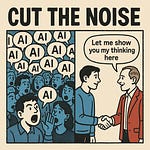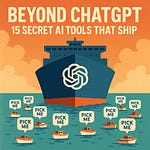Imagine you meet someone brilliant—someone who seems to know absolutely everything. Every answer they give feels sharp, insightful, even groundbreaking. Now, picture this person having one fatal flaw: every so often, they confidently state something that’s totally wrong. Not just wrong, mind you, but spectacularly incorrect—like insisting that Abraham Lincoln was a professional skateboarder. Welcome to the current state of Large Language Models (LLMs).
As fascinating and powerful as AI systems like ChatGPT and Claude have become, they still possess what I affectionately (and sometimes frustratingly) call a “frozen brain problem.” Their knowledge is permanently stuck at their last training cutoff, causing them to occasionally hallucinate answers—AI jargon for confidently stating nonsense. In my more forgiving moments, I compare it to asking a very smart student to ace an exam without any notes: impressive, yes, but prone to error and entirely reliant on memory.
That’s where Retrieval-Augmented Generation, or RAG, enters the chat. RAG fundamentally reshapes what we thought possible from AI by handing these brilliant-but-flawed models a crucial upgrade: an external, dynamic memory. Imagine giving our hypothetical brilliant person access to an extensive, always-up-to-date digital library—now every answer can be checked, validated, and supported with actual data. It’s like turning that closed-book exam into an open-book test, enabling real-time, accurate, and trustworthy answers.
The stakes couldn’t be higher. We’re moving quickly into a future where businesses, hospitals, law firms, and schools increasingly rely on AI to handle complex information retrieval and decision-making tasks. According to recent market analyses, this isn’t a niche upgrade—it’s a seismic shift expected to catapult the RAG market from $1.96 billion in 2025 to over $40 billion by 2035. Companies who fail to embrace RAG risk becoming like video rental stores in the Netflix era: quaint, nostalgic, but rapidly obsolete.
I’ve spent considerable time sifting through the noise, experimenting, succeeding, and occasionally stumbling with RAG. This document you’re holding—or, more realistically, scrolling through—is the distilled result: a 53-page guide that’s comprehensive, nuanced, and occasionally humorous (I promise, there’s levity amidst the deep dives into cosine similarity and chunking strategies). Whether you’re a curious novice or a seasoned practitioner, there’s gold here for everyone.
Inside this guide, we’ll demystify exactly how RAG works—retrieval, embedding, generation, chunking, and all—using analogies clear enough for dinner party conversations and precise enough for your next team meeting. We’ll explore advanced techniques, including hybrid searches and multi-modal retrieval, to ensure you don’t just understand RAG—you master it. We’ll even examine some cautionary tales from companies who jumped in headfirst without checking the depth (spoiler: they regret it).
Why should you read this? Because memory matters. In AI, memory isn’t a nice-to-have feature; it’s the essential backbone that transforms impressive parlor tricks into reliable, transformative technology. If you’re investing in AI, building products, or even just navigating an AI-driven world, understanding RAG isn’t optional—it’s critical.
So, pour a coffee, settle in, and let’s tackle this together. You’re about to gain the keys to AI’s memory revolution, ensuring your AI doesn’t just sound brilliant but actually knows its stuff. Welcome to your next-level guide on Retrieval-Augmented Generation: AI’s long-awaited memory upgrade.
Listen to this episode with a 7-day free trial
Subscribe to Nate’s Substack to listen to this post and get 7 days of free access to the full post archives.













